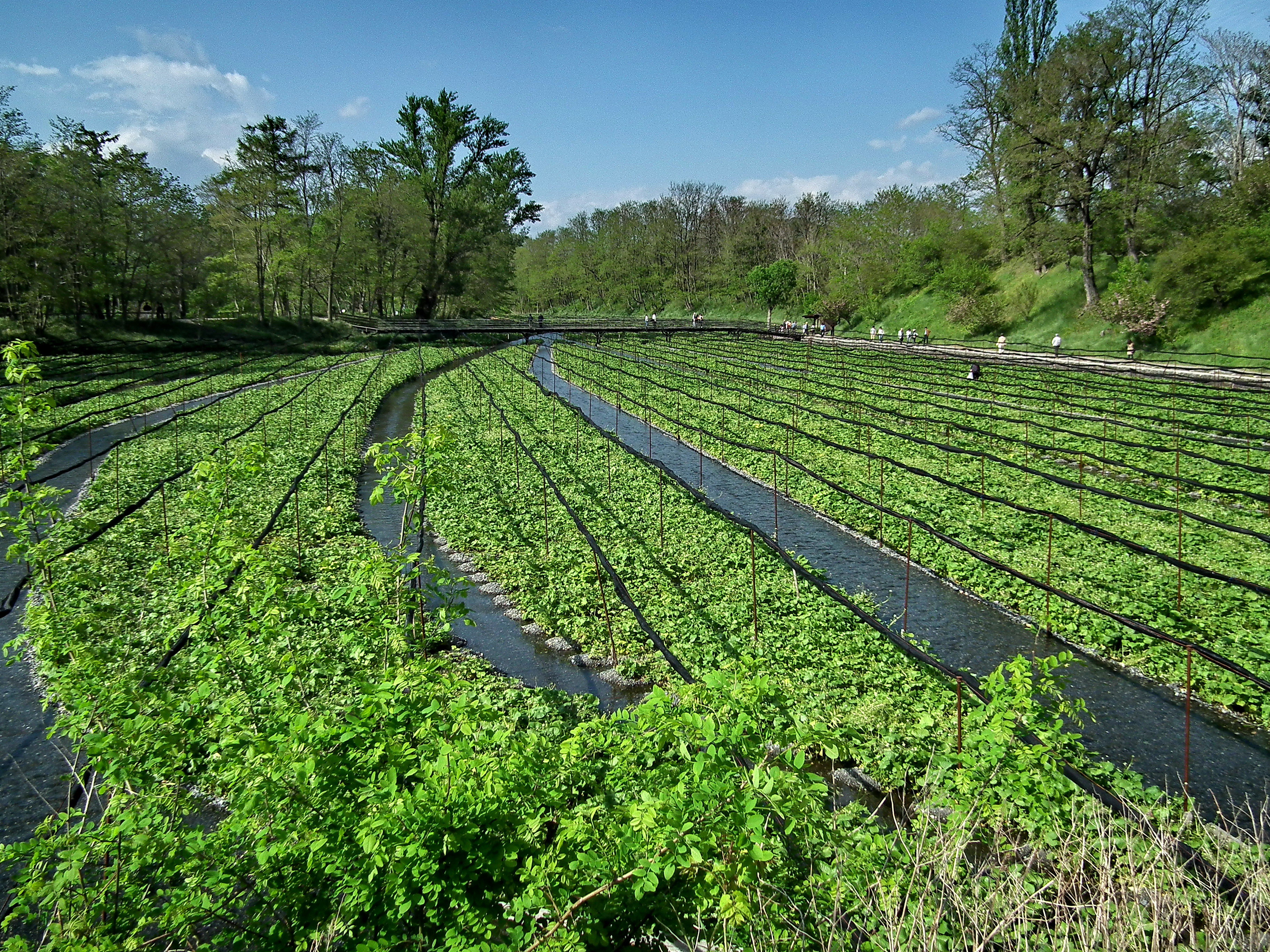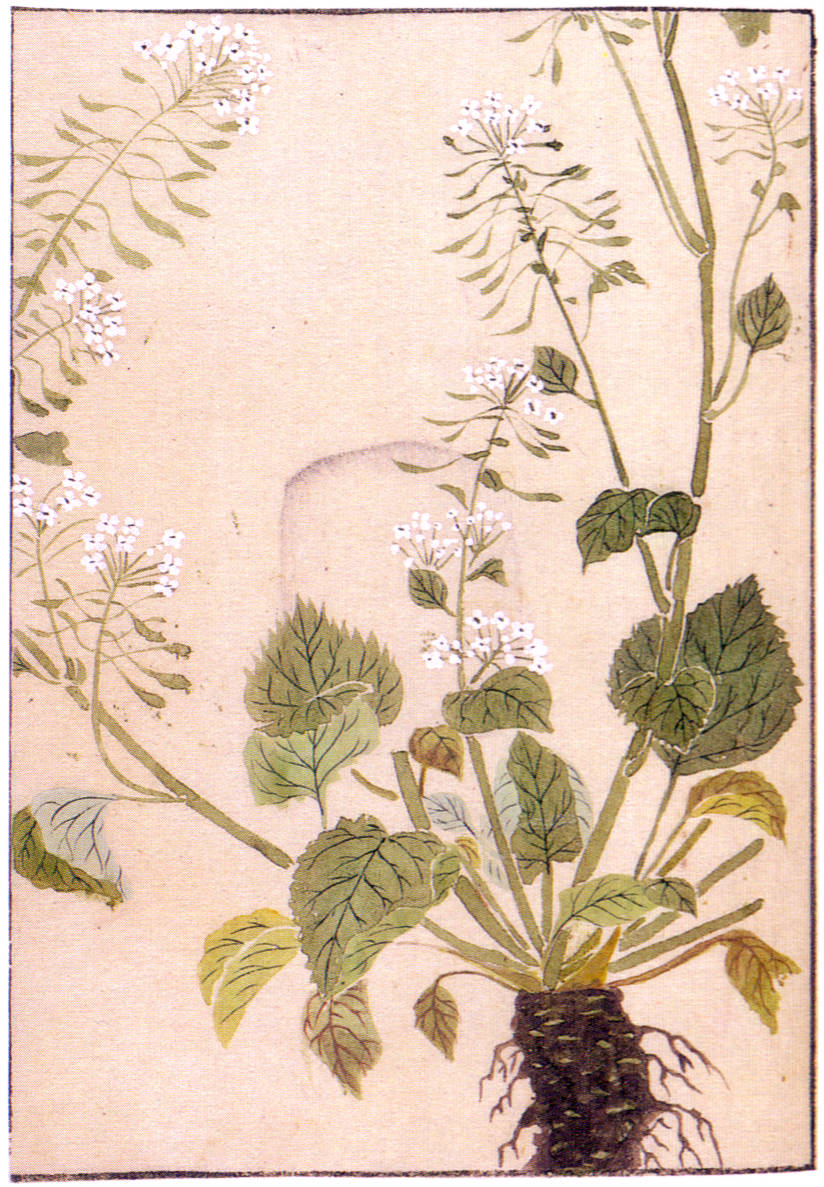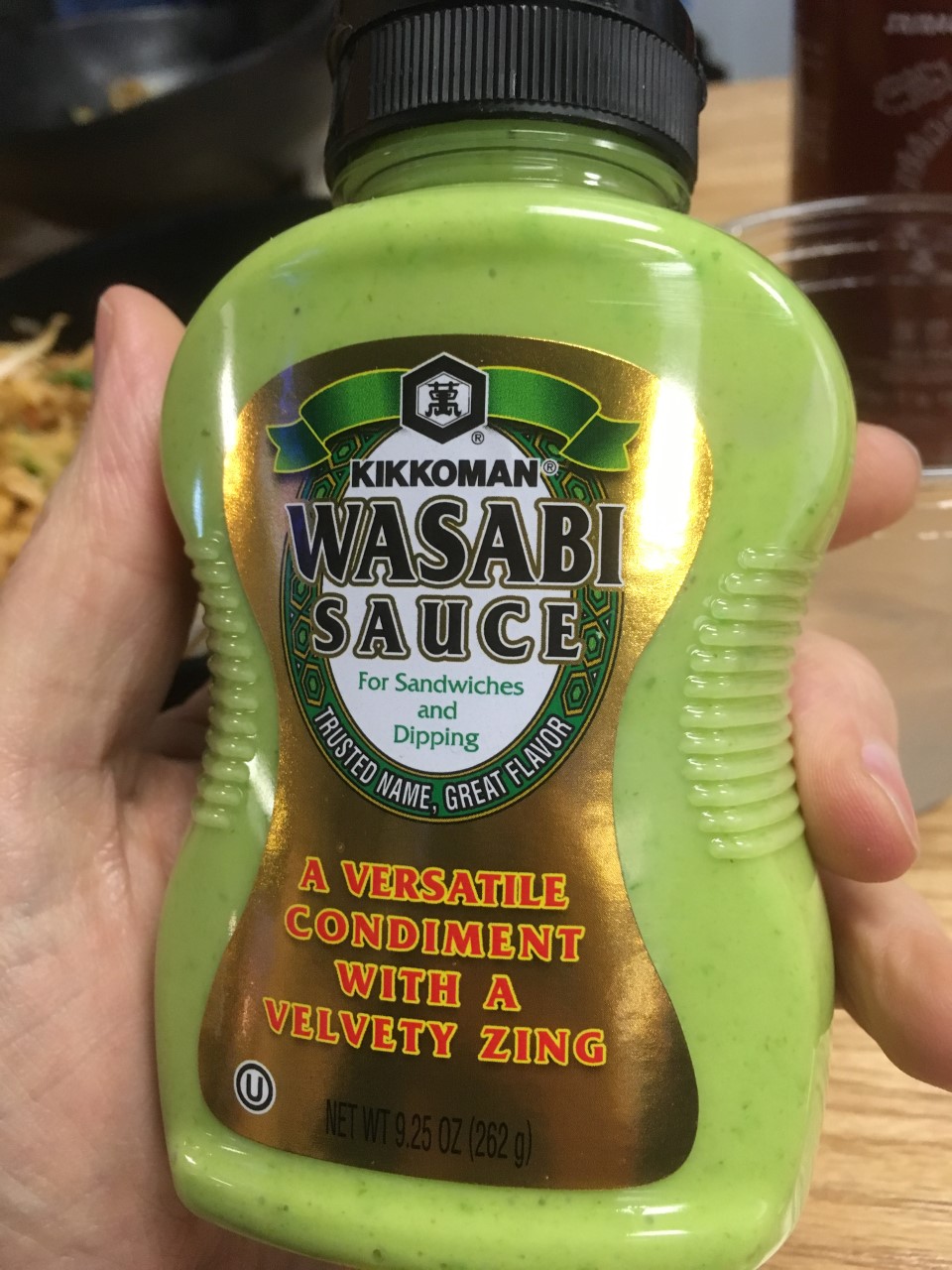Eutrema Japonicum on:
[Wikipedia]
[Google]
[Amazon]
Wasabi ( Japanese: , , or , ; ''Eutrema japonicum'' or ''Wasabia japonica'') or Japanese horseradish is a plant of the family Brassicaceae, which also includes horseradish and mustard in other
 Wasabi is generally sold either as a
Wasabi is generally sold either as a
 Wasabi favours growing conditions that restrict its wide cultivation – among other things, it is quite intolerant of direct sunlight, requires an air temperature between , and prefers high humidity in summer. This makes fully satisfying commercial demand impossible for growers, which makes wasabi quite expensive. Therefore, outside Japan,
finding real wasabi plants is rare.
A common substitute is a mixture of horseradish, mustard,
Wasabi favours growing conditions that restrict its wide cultivation – among other things, it is quite intolerant of direct sunlight, requires an air temperature between , and prefers high humidity in summer. This makes fully satisfying commercial demand impossible for growers, which makes wasabi quite expensive. Therefore, outside Japan,
finding real wasabi plants is rare.
A common substitute is a mixture of horseradish, mustard,
 Wasabi is normally consumed in such small quantities that its nutritional value is negligible. The major constituents of raw wasabi root are carbohydrates (23.5%), water (69.1%), fat (0.63%), and protein (4.8%).
Wasabi is normally consumed in such small quantities that its nutritional value is negligible. The major constituents of raw wasabi root are carbohydrates (23.5%), water (69.1%), fat (0.63%), and protein (4.8%).

 Few places are suitable for large-scale wasabi cultivation, which is difficult even in ideal conditions. In Japan, wasabi is cultivated mainly in these regions:
*
Few places are suitable for large-scale wasabi cultivation, which is difficult even in ideal conditions. In Japan, wasabi is cultivated mainly in these regions:
*
 Wasabi is often grated with a metal '' oroshigane'', but some prefer to use a more traditional tool made of dried sharkskin (fine skin on one side; coarse skin on the other). A hand-made grater with irregular shark teeth can also be used. If a shark-skin grater is unavailable, a ceramic cheese grater can be an acceptable substitute.
Wasabi is often grated with a metal '' oroshigane'', but some prefer to use a more traditional tool made of dried sharkskin (fine skin on one side; coarse skin on the other). A hand-made grater with irregular shark teeth can also be used. If a shark-skin grater is unavailable, a ceramic cheese grater can be an acceptable substitute.
genera
Genus ( plural genera ) is a taxonomic rank used in the biological classification of living and fossil organisms as well as viruses. In the hierarchy of biological classification, genus comes above species and below family. In binomial nomenclat ...
. The plant is native to Japan and the Russian Far East including Sakhalin, also the Korean Peninsula. It grows naturally along stream bed
A stream bed or streambed is the bottom of a stream or river (bathymetry) or the physical confine of the normal water flow (Channel (geography), channel). The lateral confines or channel margins are known as the stream Bank (geography), banks ...
s in mountain river valleys in Japan
Japan ( ja, 日本, or , and formally , ''Nihonkoku'') is an island country in East Asia. It is situated in the northwest Pacific Ocean, and is bordered on the west by the Sea of Japan, while extending from the Sea of Okhotsk in the north ...
.
It is grown for its rhizome
In botany and dendrology, a rhizome (; , ) is a modified subterranean plant stem that sends out roots and shoots from its nodes. Rhizomes are also called creeping rootstalks or just rootstalks. Rhizomes develop from axillary buds and grow hori ...
s which are ground into a paste as a pungent condiment for '' sushi'' and other foods. It is similar in taste to hot mustard
Mustard is a condiment made from the seeds of a mustard plant (white/yellow mustard, ''Sinapis alba''; brown mustard, ''Brassica juncea''; or black mustard, ''Brassica nigra'').
The whole, ground, cracked, or bruised mustard seeds are mixed wit ...
or horseradish rather than chili peppers in that it stimulates the nose more than the tongue, but freshly grated wasabi has a subtly distinct flavour. However, most common wasabi flavorings are ersatz, and are made of horseradish and food coloring. The two main cultivars in the marketplace are ''E. japonicum'' 'Daruma' and 'Mazuma', but there are many others.
The oldest record of wasabi as a food dates to the 8th century AD. The popularity of wasabi in English-speaking countries has coincided with that of '' sushi'', growing steadily starting in about 1980. Due to issues that limit the Japanese wasabi plant's mass cultivation and thus increase its price and decreased availability outside Japan, the western horseradish plant is generally used in place of the Japanese horseradish. This version is commonly referred to as "western wasabi" () in Japan.
Taxonomy
Siebold Siebold or von Siebold is a German surname:
* Carl Caspar von Siebold (1736–1807), surgeon
* Regina von Siebold (1771–1849), obstetrician
* Adam Elias von Siebold (1775–1828), medical doctor
* Charlotte von Siebold (1788–1859), gynaecol ...
named ''Cochlearia (?) wasabi'' in 1830, noting its use ''pro condimento'' or "as a condiment"; however, this is a ''nomen nudum
In taxonomy, a ''nomen nudum'' ('naked name'; plural ''nomina nuda'') is a designation which looks exactly like a scientific name of an organism, and may have originally been intended to be one, but it has not been published with an adequate descr ...
'', and the synonym
A synonym is a word, morpheme, or phrase that means exactly or nearly the same as another word, morpheme, or phrase in a given language. For example, in the English language, the words ''begin'', ''start'', ''commence'', and ''initiate'' are all ...
''Eutrema wasabi'', published by Maximovich in 1873, is thus an illegitimate name. The wasabi plant was first described by Miquel in 1866, as ''Lunaria (?) japonica'', from the type
Type may refer to:
Science and technology Computing
* Typing, producing text via a keyboard, typewriter, etc.
* Data type, collection of values used for computations.
* File type
* TYPE (DOS command), a command to display contents of a file.
* Ty ...
collected by Siebold in Japan, though the precise type locality
Type locality may refer to:
* Type locality (biology)
* Type locality (geology)
See also
* Local (disambiguation)
* Locality (disambiguation)
{{disambiguation ...
was not recorded.
In 1899, Matsumura erected the genus ''Wasabia
''Eutrema'' is a genus of flowering plants of the family Brassicaceae, native to the Holarctic. Its best known member is wasabi, ''Eutrema japonicum''.
Species
Species accepted by the Plants of the World Online as of October 2022:
*''Eutrema ...
'', recognizing within it the species ''Wasabia pungens'' and ''Wasabia hederaefolia''; these are now regarded as synonyms
A synonym is a word, morpheme, or phrase that means exactly or nearly the same as another word, morpheme, or phrase in a given language. For example, in the English language, the words ''begin'', ''start'', ''commence'', and ''initiate'' are all ...
of ''Eutrema japonicum''. In 1912, Matsumura recognized the species ''Wasabia japonica'', treating his earlier ''Wasabia pungens'' as a synonym. In 1930, Koidzumi transferred the wasabi plant to the genus '' Eutrema'', the correct name and author citation being ''Eutrema japonicum'' ( Miq.) Koidz.
was a Japanese botanist, author of several papers and monographs on phytogeography including work on roses and Amygdaloideae (Rosaceae), maples (Aceraceae), mulberries (the genus '' Morus''), and many other plants. His name is sometimes transli ...
Description
It has large leaves produced from long, thin stalks. They are simple and large, long and wide with palmate veins. Wasabi flowers appear in clusters from long stems that bloom from late winter to early spring.Uses
 Wasabi is generally sold either as a
Wasabi is generally sold either as a rhizome
In botany and dendrology, a rhizome (; , ) is a modified subterranean plant stem that sends out roots and shoots from its nodes. Rhizomes are also called creeping rootstalks or just rootstalks. Rhizomes develop from axillary buds and grow hori ...
or stem, which must be very finely grated before use, as dried powder, or as a ready-to-use paste in tubes similar to toothpaste tubes.
The part used for wasabi paste is variously characterised as a rhizome
In botany and dendrology, a rhizome (; , ) is a modified subterranean plant stem that sends out roots and shoots from its nodes. Rhizomes are also called creeping rootstalks or just rootstalks. Rhizomes develop from axillary buds and grow hori ...
, a stem
Stem or STEM may refer to:
Plant structures
* Plant stem, a plant's aboveground axis, made of vascular tissue, off which leaves and flowers hang
* Stipe (botany), a stalk to support some other structure
* Stipe (mycology), the stem of a mushro ...
, or the "rhizome plus the base part of the stem".
In some high-end restaurants, the paste is prepared when the customer orders, and is made using a grater to grate the stem; once the paste is prepared, it loses flavor in 15 minutes if left uncovered. In '' sushi'' preparation, chefs usually put the wasabi between the fish and the rice because covering wasabi until served preserves its flavor.
Fresh wasabi leaves can be eaten raw, having the spicy flavor of wasabi stems, but a common side effect is diarrhea.
Legume
A legume () is a plant in the family Fabaceae (or Leguminosae), or the fruit or seed of such a plant. When used as a dry grain, the seed is also called a pulse. Legumes are grown agriculturally, primarily for human consumption, for livestock f ...
s (peanuts, soybeans, or peas) may be roasted or fried, and then coated with wasabi powder mixed with sugar, salt, or oil and eaten as a crunchy snack. In Japan, it is called .
Surrogates
 Wasabi favours growing conditions that restrict its wide cultivation – among other things, it is quite intolerant of direct sunlight, requires an air temperature between , and prefers high humidity in summer. This makes fully satisfying commercial demand impossible for growers, which makes wasabi quite expensive. Therefore, outside Japan,
finding real wasabi plants is rare.
A common substitute is a mixture of horseradish, mustard,
Wasabi favours growing conditions that restrict its wide cultivation – among other things, it is quite intolerant of direct sunlight, requires an air temperature between , and prefers high humidity in summer. This makes fully satisfying commercial demand impossible for growers, which makes wasabi quite expensive. Therefore, outside Japan,
finding real wasabi plants is rare.
A common substitute is a mixture of horseradish, mustard, starch
Starch or amylum is a polymeric carbohydrate consisting of numerous glucose units joined by glycosidic bonds. This polysaccharide is produced by most green plants for energy storage. Worldwide, it is the most common carbohydrate in human diets ...
, and green food coloring or spinach powder. Often packages are labeled as wasabi while the ingredients do not actually include any part of the wasabi plant. The primary difference between the two is color, with wasabi being naturally green. Fresh horseradish root is described as having a similar (albeit simpler) flavor and texture to that of fresh wasabi.
In Japan, horseradish is referred to as . In the United States, true wasabi is generally found only at specialty grocers and high-end restaurants.
Chemistry
The chemical in wasabi that provides for its initial pungency is the volatile compound allyl isothiocyanate, which is produced by hydrolysis of natural thioglucosides (conjugates of the sugar glucose, and sulfur-containing organic compounds); the hydrolysis reaction is catalyzed by myrosinase and occurs when the enzyme is released on cell rupture caused by maceration – e.g., grating – of the plant. The same compound is responsible for the pungency of horseradish and mustard. Allyl isothiocyanate can also be released when the wasabi plants have been damaged, because it is being used as a defense mechanism. The sensory neural target of mustard oil is the chemosensory receptor, TRPA1, also known as the wasabi receptor. The unique flavor of wasabi is a result of complex chemical mixtures from the broken cells of the plant, including those resulting from the hydrolysis of thioglucosides from sinigrin into glucose and methylthioalkyl isothiocyanates: * 6-MITC * 7-Methylthioheptyl isothiocyanate * 8-Methylthiooctyl isothiocyanate Such isothiocyanates inhibit microbial growth, perhaps with implications for preserving food against spoilage and suppressing oral bacterial growth. Because the burning sensations of wasabi are not oil-based, they are short-lived compared to the effects of capsaicin in chili peppers, and are washed away with more food or liquid. The sensation is felt primarily in the nasal passage and can be quite painful depending on the amount consumed. Inhaling or sniffing wasabi vapor has an effect like smelling salts, a property exploited by researchers attempting to create a smoke alarm for the deaf. One deaf subject participating in a test of the prototype awoke within 10 seconds of wasabi vapor sprayed into his sleeping chamber. The 2011 Ig Nobel Prize in Chemistry was awarded to the researchers for determining the ideal density of airborne wasabi to wake people in the event of an emergency.Nutritional information
 Wasabi is normally consumed in such small quantities that its nutritional value is negligible. The major constituents of raw wasabi root are carbohydrates (23.5%), water (69.1%), fat (0.63%), and protein (4.8%).
Wasabi is normally consumed in such small quantities that its nutritional value is negligible. The major constituents of raw wasabi root are carbohydrates (23.5%), water (69.1%), fat (0.63%), and protein (4.8%).
Cultivation

 Few places are suitable for large-scale wasabi cultivation, which is difficult even in ideal conditions. In Japan, wasabi is cultivated mainly in these regions:
*
Few places are suitable for large-scale wasabi cultivation, which is difficult even in ideal conditions. In Japan, wasabi is cultivated mainly in these regions:
* Izu Peninsula
The is a large mountainous peninsula with a deeply indented coastline to the west of Tokyo on the Pacific coast of the island of Honshu, Japan. Formerly known as Izu Province, Izu peninsula is now a part of Shizuoka Prefecture. The peninsul ...
in Shizuoka Prefecture
is a prefecture of Japan located in the Chūbu region of Honshu. Shizuoka Prefecture has a population of 3,637,998 and has a geographic area of . Shizuoka Prefecture borders Kanagawa Prefecture to the east, Yamanashi Prefecture to the northea ...
("Traditional Wasabi Cultivation in Shizuoka, Japan" is a Globally
Globalization, or globalisation (Commonwealth English; see spelling differences), is the process of interaction and integration among people, companies, and governments worldwide. The term ''globalization'' first appeared in the early 20t ...
and Japanese Nationally Important Agricultural Heritage System)
* Nagano Prefecture
is a landlocked prefecture of Japan located in the Chūbu region of Honshū. Nagano Prefecture has a population of 2,052,493 () and has a geographic area of . Nagano Prefecture borders Niigata Prefecture to the north, Gunma Prefecture to the ...
including the Daio Wasabi Farm in Azumino (a popular tourist attraction and the world's largest commercial wasabi farm)
* Iwate Prefecture
is a prefecture of Japan located in the Tōhoku region of Honshu. It is the second-largest Japanese prefecture at , with a population of 1,210,534 (as of October 1, 2020). Iwate Prefecture borders Aomori Prefecture to the north, Akita Prefectur ...
* Shimane Prefecture
is a prefecture of Japan located in the Chūgoku region of Honshu. Shimane Prefecture is the second-least populous prefecture of Japan at 665,205 (February 1, 2021) and has a geographic area of 6,708.26 km2. Shimane Prefecture borders Yamaguc ...
known as its Hikimi wasabi
Hikimi Wasabi () is a variety of wasabi cultivated in Hikimi Town (now part of Masuda City), Shimane Prefecture, Japan.
Wasabi cultivation in Hikimi began in 1818 and by the early Shōwa era (1926–1989) reached an annual production of 300 ...
Numerous artificial cultivation facilities also exist as far north as Hokkaido and as far south as Kyushu
is the third-largest island of Japan's five main islands and the most southerly of the four largest islands ( i.e. excluding Okinawa). In the past, it has been known as , and . The historical regional name referred to Kyushu and its surroun ...
. As the demand for real wasabi is higher than that which can be produced within Japan, Japan imports copious amounts of wasabi from the United States, Canada, Taiwan, South Korea, Israel, Thailand and New Zealand. In North America
North America is a continent in the Northern Hemisphere and almost entirely within the Western Hemisphere. It is bordered to the north by the Arctic Ocean, to the east by the Atlantic Ocean, to the southeast by South America and the Car ...
, ''Wasabia japonica'' is cultivated by a handful of small farmers and companies in the rain forests on the coast of Western Canada, the Oregon Coast, and in areas of the Blue Ridge Mountains in North Carolina and Tennessee. In Europe, wasabi is grown commercially in Iceland, the Netherlands, Hungary, and the UK.
Preparation
 Wasabi is often grated with a metal '' oroshigane'', but some prefer to use a more traditional tool made of dried sharkskin (fine skin on one side; coarse skin on the other). A hand-made grater with irregular shark teeth can also be used. If a shark-skin grater is unavailable, a ceramic cheese grater can be an acceptable substitute.
Wasabi is often grated with a metal '' oroshigane'', but some prefer to use a more traditional tool made of dried sharkskin (fine skin on one side; coarse skin on the other). A hand-made grater with irregular shark teeth can also be used. If a shark-skin grater is unavailable, a ceramic cheese grater can be an acceptable substitute.
See also
* List of condiments * List of delicacies * '' Satoyama''References
Further reading
* * *External links
* * * * * {{Authority control Eutrema Japanese condiments Japanese cuisine terms Medicinal plants Spices Sushi Taxa named by Gen-ichi Koidzumi